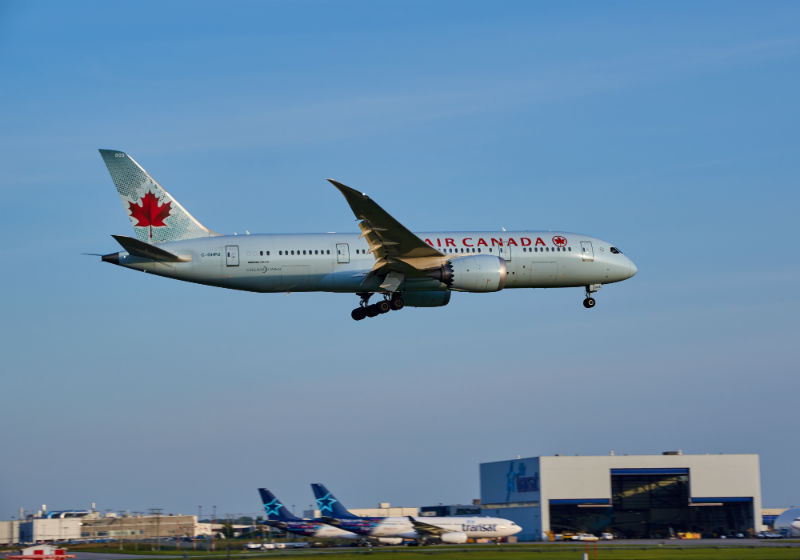
Q&A: COVID-19 protections at Pearson airport
August 17, 2020
By
OHS Canada
How Dexterra is protecting staff, travellers at Canada’s largest airport

Dexterra facilities management has been working to keep Canadian airports safe during the COVID-19 pandemic. (dzianominator/Adobe Stock)
Pearson International Airport in Toronto is the largest and busiest facility of its kind in Canada.
Throughout the COVID-19 pandemic, Dexterra has been working to provide a safe facility environment at the airport. In addition to providing services at Pearson, Dexterra also manages the international airports in Vancouver, Edmonton, Saskatoon and Regina.
Daniel Wright is vice-president of airport operations for Dexterra in Toronto.
Responses have been edited for length and clarity.

Daniel Wright is vice-president of airport operations for Dexterra in Toronto.
OHS Canada: What measures have been put in place at Pearson airport to protect travellers and staff?
Daniel Wright: In early January, when it became clear that COVID-19 was evolving into a global issue, we took decisive steps to enhance and elevate existing safety measures to protect passengers and staff at Toronto Pearson International Airport. From the beginning, our strategy was to be responsive and proactive to the ongoing crisis — although, like many others — our approach has developed over time to align with published guidance.
As with all of Dexterra’s operations, we rolled out a workplace-specific pandemic response plan. At Pearson, we immediately increased resources — onboarding almost three dozen staff in under one week — and deployed them to work in high-traffic areas to support the core team.
We complemented our existing sanitizing system with fast-acting disinfectant wipes and sprays to mitigate the risk of pathogen spread on high touchpoints (handrails, elevators, escalators, seating, monitors, screens and passenger kiosks).
We also enhanced protocols to ensure high levels of personal hygiene amongst our team, established physical distancing measures, installed Plexiglas barriers in our spaces, disinfected equipment between use and invested significantly in additional hand-sanitizing stations, which were strategically placed throughout the airport. We currently have over 400 units on the floor.
Due to the evolutionary nature of the crisis, we knew that maintaining regular and effective communication would play a vital role in allaying staff fears and misinformation; this was particularly important in the early weeks and months.
By the time the emergency stay-at-home order was put into place in Ontario, we had already taken critical steps with our strategic supply chain partners to secure and safeguard a steady stream of vital consumables, personal protective equipment and essential cleaning supplies for the airport.
As the pandemic developed, so too did our understanding of the virus, which very quickly necessitated a refresh of training across all levels of our team. As we adjusted to a new sense of normal, and to ensure all staff were equipped with the right tools and information to work safely, we embarked on an aggressive 10-day program to formally re-train some 300 managers, supervisors and front-line staff.
Consisting of 13 modules specifically linked to the pandemic, the training covered updates to policy such as absenteeism and return to work; specialized operating procedures such as physical distancing and infection control; safety talks on topics such as safe donning and doffing of masks and gloves; and key procedures on how to safely respond to a positive case of COVID-19 at the airport.
What best practices are you employing within the airport to ensure health and safety is maintained?
DW: Meeting the expectations of more than 50 million passengers (last year) requires a constant focus on innovation and the adoption of best practice.
Long before COVID-19 hit, we had already integrated a number of innovative products, systems and technologies that have allowed the team to focus their energy in refining policy and procedure to maintain a safe operation.
In addition to autonomous cleaners, Ozone sanitization and washroom dirt extraction equipment, in 2018 we invested in a new Bluetooth asset-tracking system called Lighthouse.
Through a series of 700-plus beacons, a mobile application and a web-based portal accessed by our client, our IoT solution allows us to identify the location of our staff, timestamp their movement, demonstrate when they have attended an area, and once there, confirm what work and tasks were carried out. During a pandemic, this information is critical and needs to be shared with multiple stakeholders to build confidence and demonstrate compliance to a heightened set of hygiene standards.
Keeping passengers safe means first keeping our staff healthy and safe, and throughout this crisis we have continued to put them first.
Staff have been provided with all necessary PPE; they have been supported as it relates to the need to self-isolate or take time to get tested; we embedded a pre-screening checklist into the biometric clock system that helped to flag (to managers) any issues that may need further attention and we used our foggers to mist our spaces during shift handover, which helped to clean and sanitize the air, staff equipment and their clothing as they entered and exited the airport.
In May, we completed an internal audit of our operation against guidance published by the Ministry of Labour. We used this opportunity to ensure our communication protocols and, more specifically, all of our site-level noticeboards aligned with the best practice guidance.
Throughout the pandemic, we have attended a number of Greater Toronto Airports Authority (GTAA)-led events, where representatives from all the various airport stakeholders came together to show solidarity, share knowledge, best practice and lessons learned — this really is a great example of the ‘I Am Toronto Pearson’ movement in action. We are also proud to be playing such a critical role in the new GTAA Healthy Airport initiative launched in late June, a program that is ensuring the long-term health and safety of everyone working, travelling or moving through Pearson.
With the airport being a high-traffic area, how difficult was it to establish safe policies?
DW: As a service provider at Pearson International for over three decades, we are incredibly proud of our relationship with the GTAA, which is founded on the principles of openness, transparency and the highest levels of trust and respect.
As such, we are already well-versed in the creation of policies and procedures that ensure passenger and staff safety in a secure environment.
As the pandemic progresses, our close working relationship with the GTAA ensures complete alignment from a policy perspective and as any challenges or changes in direction have occurred, we have overcome them together.
A great example of this approach in action was the GTAA move to wear mandatory face coverings.
Although not a Dexterra policy, when the policy change occurred on June 1, we simply updated our policy, communicated the requirements and retrained our staff.
In anticipation of such a move, we had already secured sufficient supplies of both surgical and washable masks, so that a variety of options could be presented to our staff.
A further example is the transparent nature that we log any positive cases of COVID-19 across our team with the GTAA.
An online log was established in May and since its launch, Dexterra has provided all required non-confidential information, living by our principles of openness and transparency.
Throughout the year, passenger opinion is canvassed by Airports Council International through the Airport Service Quality (ASQ) program.
We are incredibly proud that year-over-year for the last five years, we have steadily and constantly improved our ASQ scores in the categories of terminal and washroom cleanliness.
Our site was also successfully recertified for ISO 9001 and 14001 in December 2019.